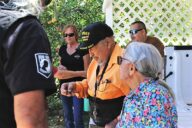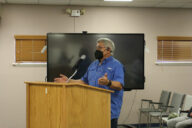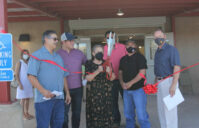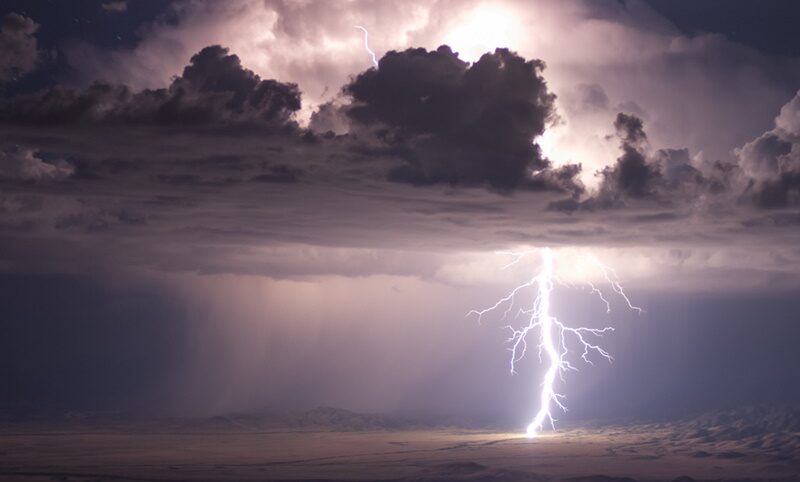
Lightning and a monsoon can be seen from the Langmuir Laboratory for Atmospheric Research. It is located at the top of the Magdalena Mountain Range in the Cibola National Forest.
Courtesy of Harald Edens
The question for Harald Edens is how do you make a spark out of nothing?
Edens is the Director of Langmuir Laboratory for Atmospheric Research, a New Mexico Tech Laboratory situated at the top of the Magdalena Mountain Range within the Cibola National Forest. The laboratory is well situated to study lightning, thunderstorms and precipitation.
The lab was built in the 1960s and named for Nobel Prize winner Irving Langmuir, who studied cloud seeding in the 1950s. An ancient goat herding pen is visible during the winding drive to the lab, hikers climb on trails in the national forest below and within the mountain is a Faraday cage, where researchers can safely study lightning.
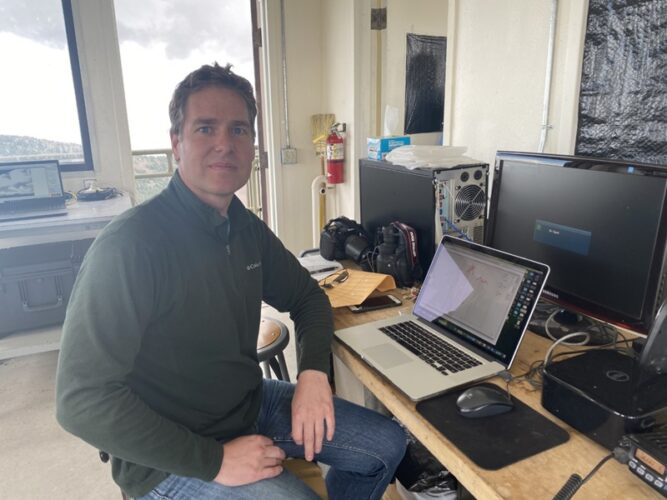
Harald Edens, Director of Langmuir Laboratory for Atmospheric Research, explains the measure of the charge of the electric field.
Caitie Ihrig | El Defensor Chieftain photos
In summer monsoon months, researchers study lightning by triggering lightning strikes. In the winter months they evaluate the data they’ve collected and create new instruments to collect more data.
Despite lightning being a common phenomenon, there is still a lot to learn about it, like exactly how thunderstorms get their charge and how lightning initiates.
Somehow, neutral molecules become free ions and free electrons briefly, which get accelerated into fields. The question is how. Many people think that cosmic rays going through the atmosphere may ionize molecules in the clouds to start the chain reaction that leads to lightning, said Edens, while others do not believe that a cosmic ray is needed and something else starts the process.
Lightning strikes travel both up and down.
“Lightning is like a tree root I would say. A tree, it has roots in the ground and it has a leaf branch structure into the air. It exchanges nutrients between the ground and the air in a way. Lightning does that with opposite charges. It’s usually between two different sides of charges. You get branches in both regions. That’s how it moves charge around. If it starts at low altitudes, one side of the lightning will hit ground and you have the lightning you see. But most lightning happens entirely within the cloud,” said Edens.
A lightning flash has two polarities, a positive charge and a negative charge connected in the middle, but exactly how those currents function is a big question.
“Every lightning flash has both polarities connected in the middle. How do they talk? How do the two ends, these advancing leader tips, how do they talk to each other?” said Edens.
Researchers trigger lightning at the lab by shooting model rockets attached to a wire into a storm cloud. Edens carefully monitors the electric field on his laptop, watching as charge builds in the cloud. The rocket has to be sent right before natural lightning would occur for there to be enough charge in the cloud to trigger lightning.

The microphone on the left is used to record thunder while the tower on the right holds up steel cabling and it used to be instrumented with weather station sensors.
Triggering lightning allows researchers to bring the lightning to the ground where their sensors are located. Researchers wait within the mountain in a steel cage 50 feet underground, named the Kiva. The Kiva is a Faraday cage, which means it creates a safe space with no electric charge for the researchers to observe lightning.
Many of the sensing instruments at the Kiva are battery powered, so that if there is a power outage the sensors continue collecting data.
“Right now we’re in waiting mode,” said Edens on Wednesday afternoon. Edens was monitoring the weather from the hillside, and keeping a look out for any hikers. If there is anyone in the area, the researchers cannot trigger lightning as a safety precaution.
A visiting volcanologist from Alabama was waiting inside the Kiva, hoping to trigger lightning to a box of volcanic ash that could be observed with high speed video cameras.
A storm looked like it might be forming overhead. A few raindrops even came down, but then the storm clouds dissipated.
Weather patterns on the mountain have changed over the years, making it more difficult to predict when storms will form. When the lab began, storms began directly overhead at 10 or 11 a.m. like clockwork, but over the years the storms have become less predictable. Typically storms these days start over the mountain at noon or even later.
“The reason they built this lab right here is this mountain range would fire off storms,” said Edens.
It is unclear exactly why the weather patterns have changed, but Edens suspects it is related to climate change. It seems like the mountain might be getting too much wind and not enough moisture. A forming storm requires a delicate balance of moisture and heat. Opposing winds can tear apart convection before a storm can form.
Along with changing weather, the technology the lab uses has changed dramatically over the years. When Van Romero, New Mexico Tech’s Vice President of Research, worked at the lab in the 70s as an undergraduate student the old lab space was filled with instrumentation. This summer the same old lab space is filled with moths. Edens and an undergraduate student work in an adjacent building, with a good vantage point of the dirt road leading up to the mountains and any storms forming overhead. The room packed with instrumentation has been replaced by a pair of computers.

Van Romero, Vice President at New Mexico Tech, worked at the lab in the 1970s as an undergraduate student.
Although researchers are still trying to answer some old questions, a lot has been learned over the years, including how to better study and track lightning.
“The more we learn, the more it seems like it’s really important to understand,” said Edens. “For instance, just a few years ago researchers discovered that thunderstorms are actually particle accelerators. There’s gamma rays coming out of thunderstorms. If you don’t know that, you don’t want to fly over a thunderstorm and get hit by those rays. That’s a hefty dose of gamma rays through your body. It goes right through the airplane.”
New Mexico Tech students have contributed valuable new instruments to the field of lightning research through their work in the lab. In 2012 a student conceived of an instrument that Edens said has transformed lightning research, because it maps lightning for an entire lightning flash, which removes ambiguity from the recorded data.
Another device that got its start in the lab is the lightning mapping array, which also maps lightning in three dimensions.
“It’s based on different principals, but that’s also an instrument that was conceived, built here in Langmuir Lab in New Mexico Tech, and that’s now become also one of the gold standard instruments in lightning research,” said Edens.
Tech has sold the lightning mapping array to several universities. One system in Lubbock, Texas is used for research and provides real time data to the airport there to help airport staff know when it’s okay to resume operations after a storm.
“Students like to build things, instruments, and this is a place to do that. You can build instruments from scratch, down to the circuit boards,” said Edens.
